DAPPER DANS’ ANGKLUNG: AN ORGAN-CHIMES-OLOGY OF A DISNEY TRADITION
This project began under the premise that the incorporation of a set of “exotic” musical instruments into the mélange of Disney spectacle was a clear case of random cultural appropriation. Further research and conclusions show that the issue may not be exactly what it seems to be.
The Walt Disney Magic Kingdom in Orlando, Florida features a barber shop quartet known as the Dapper Dans. The group, comprised of rotating cast members, is an offshoot of the original Dapper Dans, a staple at Disneyland in Anaheim, California, since 1955. Attired in colorful pin-stripe outfits, tap shoes, and straw “boater” hats, the Dapper Dans’ schtick includes their signature harmonized versions of timeless barber shop standards and Disney songs, punctuated by a patter of corny jokes.
In contrast to their Disneyland cousins, the Magic Kingdom Dans’ “acapella” performances also feature a set of hand-held, diatonically-tuned, shaken, metallic, tube-idiophones that bear a striking physical resemblance to bamboo angklung, found throughout the Indonesian archipelago. Musically, the Dans’ “angklung” performance feature both solo melodic and chordal accompaniment functions. Played in pairs by the four Dans, they produce a total of eight tones including the octave. And like their Indonesian doppelgangers, melodies are shared between players.
Initial discussions with members of the Dapper Dans revealed that the instruments were Deagan organ chimes from the early-20th century. The chimes were introduced to the group by founding member Bub Thomas when the Magic Kingdom opened in 1971.

According to www.harmonize.com/dapperdans the Magic Kingdom’s set of instruments originally belonged to vaudevillian comedienne and entertainer Billie Bird, …
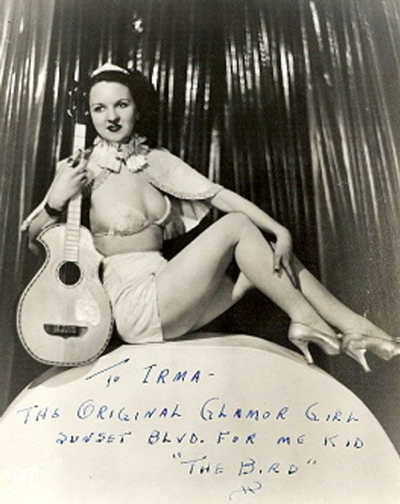
…who taught Bub how to play them while they were working together in Southern California clubs during the 1940s and 1950s. During the 1960s, Bub used the instruments in a variety of barbershopesque vocal acts, including the Terpsichords, prior to his formation of the Dapper Dans at the Magic Kingdom.

Subsequent research revealed that the J.C. Deagan Company, run by inventor and entrepreneur John Calhoun Deagan (1853-1934), was a Chicago-based manufacturer specializing in tuned percussion idiophones.
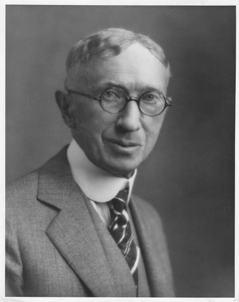
J.C. Deagan was also instrumental in the development of the modern marimba, xylophone, vibraphone, and orchestral chimes, and is also credited with the establishment of 440 Hz as the standard reference pitch in the United States. His three-pitch dinner chimes were, and still are, played as the announcement sound-bite for the National Broadcast Corporation.
As indicated by the Deagan catalog, the organ chimes were available in tuned chromatic sets of twenty to forty-four instruments and were marketed as “novelty instruments,” and purchased by circuses and vaudeville performers, from the turn of the 20th century until manufacture was discontinued in the early 1920s.
The chimes themselves are tubular, at the bottom end. A long vertical notch cut at the open top of each chime allows for precise tuning. Each individual instrument has three or four chimes tuned in octaves to a single pitch. The metal chimes were constructed from either nickel-plated steel or aluminum. Each individual chime is loosely set into a wooden base, supported by a metal frame that allows it pivot back and forth at the bottom end.
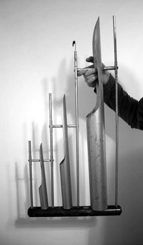
A clear resonance is produced by the manual movement of the frame forward and down, which causes the bottom of the tube to slide and knock against the end of a slot cut into the base of the frame. The organ chimes can produce a single tone and a sustained tone by shaking. Their vibration is dampened when the instruments are tipped back into the starting position.
Were the Deagan organ chimes copies of bamboo angklung?
Perhaps negating the possibility of simultaneous invention, Gary Goss, a Santa Monica street performer and owner of a set of Deagan organ chimes, states that, “…Deagan got the idea for the chimes when he attended the 1893 Chicago World’s Fair, where he saw an Indonesian group perform on the bamboo angklungs [sic].” This is supported by accounts which state that the reconstructed Sundanese village from West Java was one of the most popular attractions at the World’s Columbian Exhibition. Another source states that the Sundanese villagers remained in Chicago for a period of nine months.

A separate account from the Field Museum supports angklung performance at the Columbian Exhibition’s reconstructed Sundanese village, where “…[s]trolling through the village one heard the melodies of the angklung orchestra (tuned bamboo rattles).” Further evidence of the physical presence of angklung in North American can be traced to the early 20th century lectures of photographer Dwight Elmendorf, who “…demonstrated the use of angklung rattles and explained that the angklung was a musical instrument used in Java to accompany hobby-horse dancing and was ‘played like the chimes one sees in vaudeville.’” (‘Gossip’, The Van Wert Daily Bulleting, 2 December 1916)
It appears certain that bamboo angklung were the inspiration for the Deagan organ chimes, which J.C. had most-likely seen during the 1893 World’s Columbian Exhibition. Additional speculation suggests that he may have also had the opportunity to measure or even purchase physical instruments as models for his organ-chime design. His original patent, for the Deagan organ chimes, was dated March 6, 1900, some seven years after the Fair.
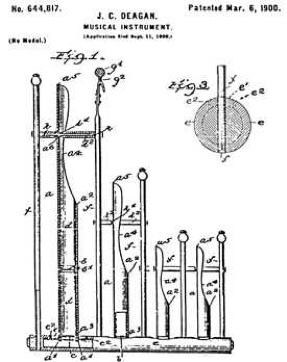
The notion that the Deagan organ-chime design was copied from an Indonesian model is further supported by the fact that both angklung and organ chimes are often stored or suspended on racks, allowing for multiple instruments to be played, in place, by a single performer.
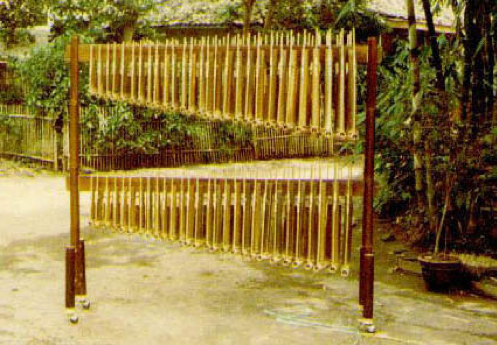

While Deagan did (perhaps) copy the Indonesian design of the bamboo angklung, it is apparent that he did not attempt to replicate the tetratonic scale common to both bamboo and metallophone angklung ensembles. The use of such a tuning system would have made the practical performance of Western diatonic music and functional harmony impossible.
After Deagan discontinued the manufacture of the organ chimes in the early 1920s, the existing sets of instruments continued to be favorited by novelty acts, which included family bands, and barber shop quartets. Today, Deagan organ chimes are displayed at the Circus World museum in Florida, and in the Percy Grainger museum in Melbourne, Australia. In addition to their continued use by the Dapper Dans, other sets of organ chimes are still in use today by contemporary performers.
In an interesting twist, the role of angklung has become a huge global phenomenon, since Da-eng So-e-tig-na created a diatonic bamboo angklung in Bandung, West Java in 1938. At present, diatonic angklung orchestras perform a wide repertoire of Western classical and popular music compositions globally. The plethora of angklung videos on YouTube include:
“The Titanic Theme” and “Bohemian Rhapsody” by Saung Angklung Udjo from Bandung, West Java; “Beethoven’s 5th Symphony” by Indah Putri from Japan; “Mission Impossible Theme” by the Angklung Hamburg Orchestra, in Germany; “Rihanna’s Umbrella” by Siarn Langsung from Melaysia; and “New York, New York” by Angklung Einhoven, in the Netherlands.
In 2010 UNESCO designated the angklung as a “Masterpiece of Oral and Intangible Heritage of Humanity.” And on July 9, 2011, 5,182 people from many nations played together in Washington DC, at an event which is listed in the Guinness Book of Records as the world’s largest angklung ensemble.
Music is a huge part of the atmosphere at all four main kingdoms, as well as the newly-christened Disney Springs at Walt Disney World. Many, but not all of the Dans’ performances include a healthy dose of Deagan organ chiming. The repertoire of the Dapper Dans is varied and wide-ranging from Stephen Foster to, Chopin, and Irving Berlin with a generous smattering of memorable Disney classics, such as “Whistle While You Work,”, The Mickey Mouse Theme Song, and“Zippity-Do-Dah.
Audience participation and involvement is a key factor in the nostalgic culture created by the Main Street appearances of the Dapper Dans. They perform informally, several times per day, without a stage on Main Street, or in the town square. Their sound is reinforced by a high-quality wireless PA system, where the surround-sound seems to simultaneously come from everywhere and nowhere at all. Guests are encouraged to participate by singing along or just general merry-making, due to the constant barrage of old jokes and comedic banter. The close interaction with the Dans, draws guests into the world of the nostalgic past. Some guests have even been coached to play one of Deagan organ-chime parts during a routine, for which they were rewarded with a certificate, certifying them as an “Honorary Ding-A-Ling.”

Conclusion
The turn-of-the-century storefronts, vintage décor, horse-drawn trolley, antique fire engine, period costumes, and Dapper Dans performances in front of the Harmony Barber Shop are all in keeping with Walt Disney’s imaginative and nostalgic recreation of the ideal small mid-western town from his youth. Together, these factors contribute to the feeling of going back in time as each visitor enters the park through the main entrance. Highly structured and planned, the sights, sounds, and smells of Main Street create a temporal and cultural barrier that immediately consumes visitors, distancing them from the outside world, while simultaneously opening them up for imaginative journeys of fantasy and adventure into both the past and the future in the many “lands” of the Magic Kingdom.
The presence of the early 20th-century Deagan organ chimes in 21st-century Orlando, Florida presents an interesting perspective into the prominent role nostalgia plays at the Magic Kingdom. The Dapper Dans and their Deagan organ chimes are critical components of Disney’s Main Street Attraction, contributing to the old-time atmosphere that immediately engulfs visitors as they enter the park. As such, the chimes add realistic authenticity to the recreation of the past so critical to the retro atmosphere of Main Street USA.
While at first both out of place and context, the appropriation and re-design of the angklung by J.C. Deagan contributes to the perpetuation of nostalgia at the Magic Kingdom in the 21st century because of the role the organ chimes played in public performances by vaudeville entertainers, family bands, and traveling circuses at the beginning of the 20th century. In this sense, Deagan organ chimes are historically accurate in the nostalgic context of the Main Street Attraction.
The Deagan organ-chime performances by the Dapper Dans at the Magic Kingdom organologically connect Indonesia with North America. They also musically connect shared expressive hocketting traditions from pre-19th-century Asia with global popular culture, such as bell choirs and pan ensembles. The angklung instrument design itself has simultaneously undergone a temporal and geographical journey from Indonesia to Florida, where it has become a permanent fixture for almost fifty years. Perhaps…it is a small world after all?
